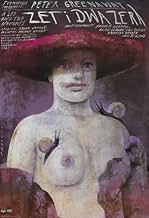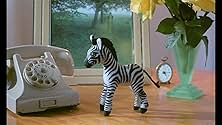AVALIAÇÃO DA IMDb
7,2/10
7,9 mil
SUA AVALIAÇÃO
Adicionar um enredo no seu idiomaTwin zoologists lose their wives in a car accident and become obsessed with decomposing animals.Twin zoologists lose their wives in a car accident and become obsessed with decomposing animals.Twin zoologists lose their wives in a car accident and become obsessed with decomposing animals.
- Direção
- Roteiristas
- Artistas
- Direção
- Roteiristas
- Elenco e equipe completos
- Produção, bilheteria e muito mais no IMDbPro
Avaliações em destaque
Peter Greenaway is arty. Painfully so. However he readily admits that this film is "self-conscious", "manufactured" and he says that all cinema is probably as "artificial" a form as you can get.
This film is beautiful to look at. Greenaway was inspired, visually, by paintings of the mid 17th century, particularly those of Vermeer. Almost every shot is composed like a painting. Many of the shots are symmetrical, walls are filmed flat so that the horizontal lines are parallel with the top and bottom of the frame. Objects are placed on tables as if subjects for a still life. Lighting is used in an alternation of light, shade,light,shade receding to the back of the picture, which is a signature of the type of 17th century, Western art that Greenaway is paying homage to.
The substance of the film follows weighty themes, all of which are explained in great detail through the director's commentary: evolution, light and twin-ship.
What is lacking is emotion. This is a cerebral film. Your emotional reaction to it will be through the imagery, be it beautiful or repulsive. You will not engage with the characters on an emotional level. You'll find them hard to relate to. The performances are stilted and amateur theatrical. It is fortunate, then, that Michael Nyman provides a fantastic score (present on almost every scene and almost outstaying its welcome) which prevents the dialogue (the script leaves a lot to be desired too) rendering everything flat.
Rent this if you enjoy visuals for their own sake, if you wear spectacles and if you like holding your chin in your hand and frowning. I qualify on all those points, so I enjoyed it a great deal.
Extra points for an extraordinarily thorough director's commentary on the DVD which serves to pull out all the hidden depths. Though one could make the point that an explanation that adds so much extra understanding leaves you feeling that the film failed adequately to convey much of what was intended.
DVD easter eggs (worth seeing): http://www.dvd.net.au/hidden.cgi?movie_id=10484
This film is beautiful to look at. Greenaway was inspired, visually, by paintings of the mid 17th century, particularly those of Vermeer. Almost every shot is composed like a painting. Many of the shots are symmetrical, walls are filmed flat so that the horizontal lines are parallel with the top and bottom of the frame. Objects are placed on tables as if subjects for a still life. Lighting is used in an alternation of light, shade,light,shade receding to the back of the picture, which is a signature of the type of 17th century, Western art that Greenaway is paying homage to.
The substance of the film follows weighty themes, all of which are explained in great detail through the director's commentary: evolution, light and twin-ship.
What is lacking is emotion. This is a cerebral film. Your emotional reaction to it will be through the imagery, be it beautiful or repulsive. You will not engage with the characters on an emotional level. You'll find them hard to relate to. The performances are stilted and amateur theatrical. It is fortunate, then, that Michael Nyman provides a fantastic score (present on almost every scene and almost outstaying its welcome) which prevents the dialogue (the script leaves a lot to be desired too) rendering everything flat.
Rent this if you enjoy visuals for their own sake, if you wear spectacles and if you like holding your chin in your hand and frowning. I qualify on all those points, so I enjoyed it a great deal.
Extra points for an extraordinarily thorough director's commentary on the DVD which serves to pull out all the hidden depths. Though one could make the point that an explanation that adds so much extra understanding leaves you feeling that the film failed adequately to convey much of what was intended.
DVD easter eggs (worth seeing): http://www.dvd.net.au/hidden.cgi?movie_id=10484
A rewarding post modern film about life and decay and the effects of a single moment on a person's life. Great sets and photography by the legendary cinematographer Sacha Vierny, this film makes you ultra aware that you are watching a film, or a sort of theatrical filmed piece. Greenaway is an aquired but very rewarding taste, and no other director makes films as he does. A disturbing somber film for serious fans of modern cinema. Greenaway is a must in your education of film.
This is definitely one of the more disgusting films I've watched, and not in a good way. This movie made me physically ill, and though it was mind-bending and beautifully coreographed, the subject matter and the lead characters' inevitable decline into utter insanity that is characteristic of Greenaway films was a bit much for me. I'm saying this and I loved Santa Sangre. Go figure.
A pair of twin brothers (who have different hair color somehow, and as it turns out were originally Siamese twins) become obsessed with the subjects of decay, evolution, and greif when their wives are killed in a car crash at the Zoo. They start conducting utterly repulsive experiments that involve time-elapse films of animals and fruits rotting away. And to top it all off, there's a plot in all of this, by a couple of poachers posing as zoo staff who plan to make a profit from all this. The rest is just entirely too disgusting/weird/complicated to explain clearly, but I will give you some hints about the ending: It involves a rack. And snails. And floodlights. And a record player.
A pair of twin brothers (who have different hair color somehow, and as it turns out were originally Siamese twins) become obsessed with the subjects of decay, evolution, and greif when their wives are killed in a car crash at the Zoo. They start conducting utterly repulsive experiments that involve time-elapse films of animals and fruits rotting away. And to top it all off, there's a plot in all of this, by a couple of poachers posing as zoo staff who plan to make a profit from all this. The rest is just entirely too disgusting/weird/complicated to explain clearly, but I will give you some hints about the ending: It involves a rack. And snails. And floodlights. And a record player.
Greenaway's obsessions with lists, wordplay, coincidence, sexuality, the surreal, and the explicit (not to mention the "conventionally used" ones like men and women, birth and eating and death, physiology (formal and psychological), and abstraction) come to a head in this film. A bizarre mileau of fancy digressions and focused narrativity create a film which is perhaps too obtuse for first time viewers but is, as far as I'm concerned, the best way to initiate oneself into the "world" of Greenaway.
All you need to make cinema is a point of view (and of course the view to which it points). Or a frame of reference and the reference which it frames. In Greenaway all these exist together, knowingly, as forms within forms.
A story of twins looking to overcome grief by studying the decay of death is the reference here. Zebras, lizards, swans, we see the empty shells of body decay before the camera. Kept under the scrutiny of our gaze in life, inside cages, they remain under it once dead. At what point do all these symmetries which conjoined together make up the miracle of life stop being the sum of their parts, and by which process; how much of these parts that we understand as the self can be taken out before the self is no longer recognized; and the symmetry once broken, what mystery renews it.
These obscure ruminations are framed against the question of existence, which implies god and pattern. How come that something so systemised, so perfectly designed and evolved from nothing, from amoeba and algea, can come to pass by the whim of chance? Having taken millions of years for creation to unravel its complexity, why does it take a second to destroy it? Which is to ask, at what point does the system, which in hindsight appears ordained and patterned, become random and meaningless.
Various eccentricities are enacted in this process, all pointing to some kind of symbolic nakedness.
When the legless woman gives birth to new life, twins again, the old twins, the blueprint for them, must step aside. The film ends with an poignant thought. Having carefully staged their own death so that the decay that follows may be captured on film, we see how nature intrudes upon this scene and foils the effort.
An atheist himself, Greenaway here gives us a pessimism that cuts deep; no consciousness survives this.
A story of twins looking to overcome grief by studying the decay of death is the reference here. Zebras, lizards, swans, we see the empty shells of body decay before the camera. Kept under the scrutiny of our gaze in life, inside cages, they remain under it once dead. At what point do all these symmetries which conjoined together make up the miracle of life stop being the sum of their parts, and by which process; how much of these parts that we understand as the self can be taken out before the self is no longer recognized; and the symmetry once broken, what mystery renews it.
These obscure ruminations are framed against the question of existence, which implies god and pattern. How come that something so systemised, so perfectly designed and evolved from nothing, from amoeba and algea, can come to pass by the whim of chance? Having taken millions of years for creation to unravel its complexity, why does it take a second to destroy it? Which is to ask, at what point does the system, which in hindsight appears ordained and patterned, become random and meaningless.
Various eccentricities are enacted in this process, all pointing to some kind of symbolic nakedness.
When the legless woman gives birth to new life, twins again, the old twins, the blueprint for them, must step aside. The film ends with an poignant thought. Having carefully staged their own death so that the decay that follows may be captured on film, we see how nature intrudes upon this scene and foils the effort.
An atheist himself, Greenaway here gives us a pessimism that cuts deep; no consciousness survives this.
Você sabia?
- CuriosidadesThis film was Peter Greenaway's first collaboration with cinematographer Sacha Vierny, who went on to shoot virtually all of Greenaway's work in the 1980s and 1990s, until Vierny's death in 2001. Greenaway referred to Vierny as his "most important collaborator".
- Citações
Alba Bewick: In the land of the legless the one-legged woman is queen.
- ConexõesFeatured in Peter Greenaway (1992)
- Trilhas sonorasThe Teddy Bears' Picnic
Music by John W. Bratton
Lyrics by Jimmy Kennedy
Performed by The BBC Dance Orchestra
Directed by Henry Hall
Courtesy of EMI MUSIC PUBLISHING LTD and EMI RECORDS LTD
Also sung by Venus De Milo (Frances Barber)
Principais escolhas
Faça login para avaliar e ver a lista de recomendações personalizadas
- How long is A Zed & Two Noughts?Fornecido pela Alexa
Detalhes
- Data de lançamento
- Países de origem
- Idiomas
- Também conhecido como
- A Zed & Two Noughts
- Locações de filme
- Empresas de produção
- Consulte mais créditos da empresa na IMDbPro
Contribua para esta página
Sugerir uma alteração ou adicionar conteúdo ausente

Principal brecha
By what name was Zoo - Um Z E Dois Zeros (1985) officially released in Canada in English?
Responda




























